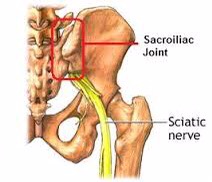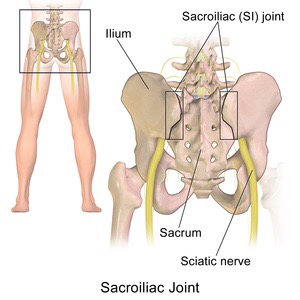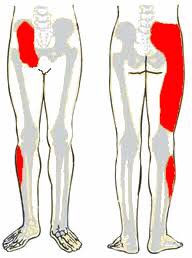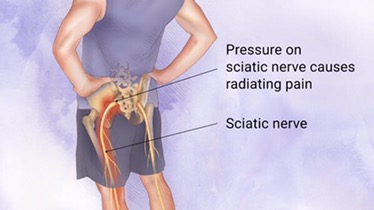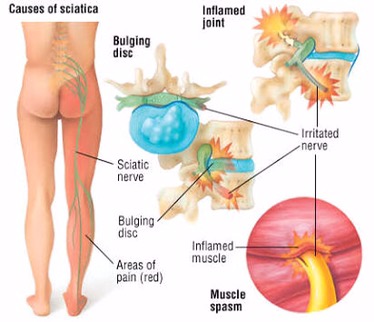Sciatica is a condition in which nerve impingement is felt along with pain in the buttocks and legs as a result. It often results from a disc, bone spur, or other spine-related issues causing pressure on the sciatic nerve. If you are experiencing any of these signs it is important to consult your doctor as soon as possible to get an accurate diagnosis and determine the best course of action. Sciatica Or SI Joint Dysfunction? Find the true cause of pain, sacroiliac joint sciatica, sciatica symptoms, and other important information in this article.
Introduction
SACROILIAC dysfunction and instability”, generally refers to pain in the sacroiliac joint region that is caused by abnormal motion in the sacroiliac joint, either too much motion or too little motion. It typically results in inflammation of the sacroiliac joint and can be debilitating.
How do you know if it is sciatica?
Sciatica is a medical condition that is caused by compression of the sciatic nerve, resulting in pain that radiates down a person’s legs. The most common symptom of sciatica is pain that originates in the lower back and can be felt anywhere from the buttocks to the toes. Another common symptom is a feeling of tingling or burning along the path of the nerve, as well as sensations of numbness. When attempting to diagnose whether someone has sciatica, they may undergo imaging tests such as an X-ray, MRI, or CT scan to help pinpoint if their symptoms are caused by a herniated disc or other spinal disorder. It is important to consult with your doctor if you experience any of these signs to ensure proper diagnosis and treatment.
More symptoms include sciatic leg pain, groin pain, hip pain, urinary frequency, and “transient numbness, prickling, or tingling. Pain can range from dull aching to sharp and stabbing and increases with physical activity. Symptoms also worsen with prolonged or sustained positions (i.e., sitting, standing, lying). Bending forward, stair climbing, hill climbing, and rising from a seated position can also provoke pain. Pain is reported to increase during menstruation in women.
Also Read: How Physiotherapy May Help You With Your Joint Problems?
Difference between SI joint pain and sciatica: SI joint pain vs sciatica
Though both SI joint pain and sciatica are common forms of lower back pain, they are very different issues. SI joint pain is usually caused by the lower spine’s sacroiliac (SI) joints becoming inflamed, while sciatica is caused by a compressed or irritated sciatic nerve root. Despite the difference in the cause, however, both conditions have similar symptoms like sharp pain in the lower back region that may radiate to the hips or buttocks and shooting pains that can be excruciating if left untreated. Luckily, effective treatments exist for SI joint pain and sciatica, ranging from lifestyle changes to medications and physical therapies designed to build strength, flexibility, and balance around the affected area. Understanding more about these two painful conditions can help people accurately diagnose their symptoms and properly treat them for lasting relief.
Useful exercises for sciatica
Exercise is an important part of managing sciatica and keeping up with a routine can be very beneficial. Studies have shown that gentle stretching and movement like walking, swimming, or stretching can help reduce inflammation in the lower back and reduce stress on the sciatic nerve. Additionally, specific core exercises such as planks, bridges, and clamshells help strengthen the back muscles to provide greater support for the spine. Incorporating flexibility exercises such as yoga or Pilates can increase the range of motion and help improve how the spine moves. It’s also important to note that it’s best to consult with a physician before starting any new exercise program as some things may worsen symptoms of sciatica.
Top 6 Sciatica Symptoms and Cause Of Pain
Sciatica is a condition that can be painful and debilitating, but it’s important to recognize its symptoms to figure out the right course of action. It’s a good idea to be aware of the top 6 sciatica symptoms because if you’re experiencing more than one of them, you may want to talk to your doctor. Pain in one leg, numbness and tingling sensation in the lower body, difficulty moving your leg or foot, stabbing pain that makes it hard to stand up and sit down, muscle weakness or difficulty with bladder or bowel control; these are some of the primary signs associated with sciatica. Consulting your doctor for any combination of these symptoms is always important as it can help you determine if you have a sciatica-related issue at hand.
SACROILIAC JOINT AND SCIATIC NERVE
Sciatica Or SI Joint Dysfunction? Find The True Cause Of Pain
SACROILIAC dysfunction and instability”, generally refers to pain in the sacroiliac joint region that is caused by abnormal motion in the sacroiliac joint, either too much motion or too little motion. It typically results in inflammation of the sacroiliac joint, and can be debilitating.
Sacroiliac Joint
SCIATICA is a fairly common cause of back pain. It is characterized by sharp nerve pain that shoots down the buttocks and into the leg, usually on one side of the body.
It is important to note that another common cause of lower back pain, sacroiliac (SI) joint dysfunction, can cause a very similar pain pattern. Common symptoms include lower back pain, buttocks pain, sciatic leg pain, groin pain, hip pain , urinary frequency, and “transient numbness, prickling, or tingling. Pain can range from dull aching to sharp and stabbing and increases with physical activity.Symptoms also worsen with prolonged or sustained positions (i.e., sitting, standing, lying).Bending forward, stair climbing, hill climbing, and rising from a seated position can also provoke pain. Pain is reported to increase during menstruation in women.
REFFERED PAIN PATTERN IN SACROILIAC JOINT PAIN
Sciatica is more well-known than SI joint dysfunction, so the chance of receiving a proper back pain diagnosis for SI problems is lower.
Affected muscle groups in SI JOINT DYSFUNCTION Edit
Many large and small muscles have relationships with the ligaments of the sacroiliac joint including the PIRIFORMIS, rectus femoris, gluteus maximus and minimus, erector spinae, latissimus dorsi, thoracolumbar fascia, and iliacus. Any of these muscles can be involved or spasm with a painful and dysfunctional sacroiliac joint.The SI joint is a pain-sensitive structure richly innervated by a combination of unmyelinated free nerve endings and the posterior primary rami of spinal segments L2-S3. The wide possibility of innervation may explain why pain originating from the joint can manifest in so many various ways, with different and unique referral patterns for individual patients.Patients with sacroiliac joint dysfunction can also develop tightness and dysfunction in the hamstring, quadriceps, iliotibial tract and hip flexors, including the psoas muscle.
Sciatica is caused by a compression or irritation of the sciatic nerve, which runs from the lumbar spine down to the foot on each side of the body. The condition has a number of potential causes, including lumbar disc herniation and piriformis syndrome, spinal stenosis, spondylolysthesis. The pain generally starts in the lower back and can travel as far down as the foot.
SCIATICA PAIN
The SI joints are located at the back of the pelvic girdle where the hip bones (ilia) meet the base of the spine (sacrum). A number of situations can cause an SI joint to be either too mobile or not mobile enough. Impact from a fall, for example, can wrench the joint out of its normal limited range of motion. Hormonal changes during pregnancy cause ligaments to loosen, potentially causing the SI joints to become hypermobile. Poor body mechanics, such as gait problems due to flat feet or leg length discrepancy, can cause excess stress on an SI joint. Any biomechanical dysfunction affecting the alignment of and forces on the pelvis can irritate one or both SI joints. The symptoms of this condition are very similar to sciatica: a sharp pain that shoots through the buttocks and down the leg.
COMMON CAUSES OF SCIATICA
A few common discrepancies between symptoms may help to differentiate the two conditions. SI joint pain often doesn’t travel lower than the knee, though it can; sciatica symptoms often occur below knee level. If the SI joint is hypermobile, it can tug on the dense web of ligaments and muscles that support it. Pain from this can be expected to manifest mainly in the hips and lower back, and may radiate to the groin. SI pain is usually triggered by standing on the leg on the side of the affected joint.
On top of the similarity of symptoms, distinguishing between these two conditions is further complicated by the fact that SI joint dysfunction and sciatica may co-exist. When an SI joint is irritated, either by hyper- or hypomobility, it becomes inflamed. The sciatic nerve, which runs near the joint on its journey down to the leg, can become irritated by this inflammation.
Exercise therapy is also used for both conditions, but the exercises prescribed differ. Whether the SI joint is hyper- or hypomobile also needs to be determined, since hypermobility requires stabilization and hypomobility requires mobilization.
Being aware of common misdiagnoses puts you in a position to find your real back pain cause. There is significant overlap of symptoms between sciatica and SI joint dysfunction; be aware that these two conditions are often distinct phenomena that require different treatments.
How Physiotherapy Can Help?
Physiotherapy is a great way to manage sciatica, a condition caused by compression of the sciatic nerve. When properly applied it can significantly reduce pain and improve disability caused by sciatica. Through assessment, certain exercises, and manual techniques such as massages and other forms of treatments done by trained physiotherapy professionals, physiotherapy can provide relief to those suffering from sciatica. It can also reduce inflammation, help improve muscle strength, and help to maintain proper biomechanical alignment of the lower back and legs. With regular treatment, those with chronic symptoms can experience more comfort and an improved quality of life.
Recovering from Sciatica Do’s and Don’ts
Following the right dos and don’ts can make the process of recovering from sciatica easier. It’s important to pay attention to the do’s and don’ts, as failing to follow these could result in worsening your condition or prolonging your recovery period. Many people find it helpful to focus on positive changes such as getting enough rest, stretching regularly, increasing movement through physical therapy exercises, and avoiding activities that aggravate their pain. On the other hand, people should avoid sudden movements or jerking motions that could further irritate the sciatic nerve, increase inflammation around the spine, or worsen any existing conditions like herniated discs. Follow these tips to ensure you are on the path to recovery from your sciatica pain safely and effectively.
Does sciatica ever fully heal?
Sciatica can be a serious and painful affliction, but thankfully there are ways for sufferers to find relief. Many people find that with the proper treatments, sciatica does not only fade away, but it can heal completely. While not all cases of sciatica fully resolve, there is evidence that this condition can be healed in many instances – eliminating the pain and discomfort once and for all. As such, sciatica sufferers need to take advantage of all their treatment options so their bodies have the chance to fight off this debilitating medical condition.
We hope this article has helped you gather information about various aspects of sacroiliac joint sciatica, SI joint pain vs sciatica, as well as sciatica symptoms and their management.
Also Read: What is Piriformis Syndrome and Common Causes?
Written and complied by
Dr Divya Gaur
Senior Physio

